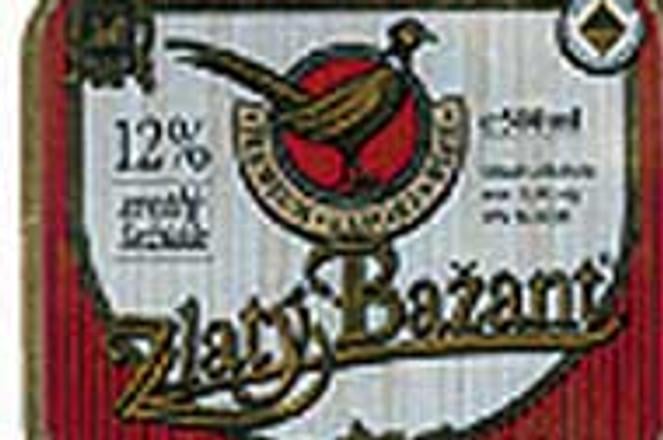Zlatý Bažant's current label (left) after Heineken's makeover in 1995.Photo : Courtesy of Zlatý Bažant
The Dutch brewery Heineken swallowed up another large chunk of the Slovak beer market on December 16 when it signed a contract giving it a 51.1% stake in the KK Company brewery in Martin and a 52.5% share in Rimavská Sobota's Gemer Brewery. The new acquisitions give Heineken now four breweries in Slovakia and a 37% share of the market. The deal awaits only official approval from the Slovak Antitrust Bureau, which is expected this week.
Jean-Paul van Hollebeke, managing director of Heineken Slovakia, told The Slovak Spectator on January 4 that competition between the firm's Slovak brands - Zlatý Bažant, Corgoň, Martiner and Gemer - was not a concern. Instead, through product-positioning and intensive marketing campaigns, each beer would cater to a separate specific market.
Van Hollebeke outlined Heineken's marketing strategy. Zlatý Bažant's Kelt beer, he said, was designed to compete with popular Czech labels like Pilsner Urquell and Budvar, and represented Heineken Slovakia's flagship brand. A slot lower on the totem pole, and priced slightly cheaper than Kelt, sits the solid quality Zlaty Bažant. Corgon, aimed at young, athletic types, is positioned just beneath Zlatý Bažant.
Heineken's new Martiner and Gemer brands will be 'price-point' (ie. cheaper) beers, and will be sold regionally - Martiner in central Slovakia and Gemer in the eastern half of the country. Zlatý Bažant is available nation-wide, and Van Hollebeke expected Corgoň, presently available in the country's larger towns, to penetrate into the smaller towns within the year.
Initial reactions
The Heineken acquisitions had at least one Slovak competitor worried about the Dutch giant's market dominance.
Topvar Brewery's Managing Director, Peter Vendelin, said that he feared Heineken's 37% market share might grow further during the coming years. "Time will show you what will happen," he said. "Heineken is going strengthen their presence on the Slovak market and will probably own 40% to 50% of the Slovak beer market. This is a question for the Antitrust Bureau, because this could be seen as a monopoly and competition must exist."
Given Topvar's latest results, though, Vendelin may have little to fear from the competition. Located in the central Slovak town of Topoľčany, the brewery sold a record 588,000 hectoliters of beer in 1999, 20,000 up on the year before. Topvar is the largest brewery in the country owned exclusively by Slovaks (with 12% market share), and is Heineken's main competition after the South African Breweries' Šariš firm.
"Topvar is a well known brand and we are making a profit and sales have been increasing, and I don't expect that to change this year," Vendelin said. "If it is necessary to change our marketing strategy to compete, we will deal with this when the time comes."
Heineken purchased Zlatý Bažant in 1995, and Corgon has been under its control since 1997. The old Zlatý Bažant label had 8% market share at the time its purchase by Heineken, and now has 18%, a gain that has allowed it to leap from fourth to first place among Slovak beers.
Corgoň has seen similar growth from the Heineken take-over, holding just under 7% of the market at the time of the purchase and now expecting to take a 9% share when the figures are tallied for 1999.
Dušan Pavlišin, marketing manager for Heineken Slovakia, attributed much of the growth Zlatý Bažant and and Corgoň have seen to changes implemented by Heineken. The brands' increased presence at high-profile events and festivals, as well as in the media, have in Pavlišin's view played a major role in the increased popularity of the brews.
The consumer has seen new labels and a more consistent taste since Heineken took over each beer. Corgoň's taste was altered to make it less bitter.
"After the entry of Heineken, the quality of the products improved and the marketing has become a lot better through analysis and research," Pavlišin said. "We began to focus not only on the media campaign, but also on promotional events like free beer tasting."
The new breweries hope to cash in on Heineken's touch. Although specific strategies for the new acquisitions have yet to be determined, preliminary plans for the breweries include imposing quality control standards similar to those at Zlatý Bažant and Corgoň. Presently, Gemer and Martiner hold a combined 15% market share.
Customer response
In Banská Bystrica, 43 year-old bartender Peter Kán has been pulling back the taps for thirsty patrons for nearly 30 years. Presently Kán works at Slovenská Pivnica restaurant, where thirsty patrons have a choice between the Czech beer Pilsner Urquell and Martiner.
The barkeeper said that the majority of patrons seemed to enjoy Martiner, although he himself thought the brand could be improved. "I don't drink beer regularly, but when I do, I like a good head on my beer. I think the beer is good, but the head isn't thick enough, it flows off the sides too easily," he said.
Regarding the Heineken acquisition of the Martiner label, Kán said he expected the quality of the product to improve and the foam problem to be cured.
Van Hollebeck said quality-controls had already begun and should be completed within the next few weeks. Marketing strategies would take a bit more time, he said, as people's perceptions did not change overnight.
"It's difficult to say at this point what changes will be made in Gemer and Martiner," he said. "We have some ideas that need to be fine-tuned through market research, but it is difficult to say exactly what is going to be done."
The recent deals show that Heineken is committed to the domestic market. "Despite an economic situation that was not that attractive at the time we first arrived, all our decisions are based on a strong conviction that this country is going to develop quickly and that the market will stabilise," van Hollebeke said.

